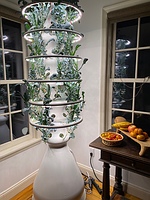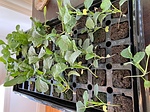Stress-Free Farming
I’m not sure how or when it started but for a while I’ve had an – obsession is too strong of a word – urge, let’s say, to grow food. Call it the “Gentleman Farmer” fantasy if the gentleman in question skipped the blazer and breeches and went instead for tattered sweatpants and mismatched socks. And in this area, you learn quickly that almost anything you grow unprotected outdoors will likely feed bugs, birds, groundhogs and deer before it ever hits your table.
Apparently, my phone was listening because I started getting ads for indoor hydroponic setups, some small enough to fit on a countertop and others that could fill a picture window. I ended up going with the Lettuce Grow Farmstand because it was modular, meaning I could start small, and circular, which made me think I could grow more in less space. (I have no idea if that last part is true. I’m a gentleman, after all, not an engineer.)
The whole setup works like this: after the simple assembly, you fill the base with water, nutrients and a substance to adjust the PH (a measure of how acidic/ basic the water is) to the proper level for the plants to best absorb said nutrients. Don’t freak out over the PH thing. It’s super easy, and you’ll feel like a Nobel-winning chemist when you drop “PH” in casual conversation. Then you plug it in, and a pump on a timer will push the nutrified water to the top of the tower. As it falls – burbling pleasantly - it will feed and water your plants, which are slotted into the tower in individual holders. Growing indoors, you’ll need to buy the LED light rings that are sold separately. The power draw for the pump and lights is minimal. You’ll need to replenish the water and nutrients and rebalance the PH once per week. Takes five minutes. I haven’t checked out other growing setups, but they probably work similarly since all plants need light, water and food.
Surprisingly, you can grow flowers, herbs and even tomatoes in the thing year-round without pesticides. I started with kale, lettuce and chard and couldn’t keep up with the lettuce and chard. The growth was that fast, and the taste, freshness and appearance were unbeatable.
Many of these companies sell seedlings, which are expensive and get shipped heavily packaged from far-away places. I bought a little seed germination kit for the price of about three seedlings and have since popped and transplanted over 100 plants to the tower. We make green smoothies every day with kale, and we haven’t bought kale in six months. Germinating your own seeds is the way to go. It’s not difficult, seeds are cheap, and nurturing them from that little envelope to your table can get you that much closer to fulfilling your farmer fantasies.



